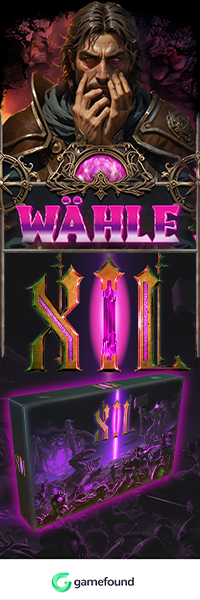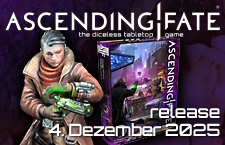AoSRPG: Neues zur Spielmechanik
Cubicle 7 Entertainment stellen die Spielmechanik für das kommende AoS RPG etwas genauer vor.
SOULBOUND: How Tests Work
How Tests Work – Part 1
Welcome back to #MortalRealmsMonday! Following last weeks jam-packed announcement, we wanted to change direction and give an insight into how Age of Sigmar: Soulbound will play. So this week, we’re talking about Tests.
Tests
The core of Soulbound involves Tests. Everything you do, from exploration, to roleplaying, to combat, will involve making Tests. You will make a Test when you attempt to do something where the outcome is uncertain or when someone is opposing your action. To make a Test, you will assemble your pool of six-sided dice (d6s) and try to meet or exceed the Difficulty Number (DN) of the Test. Before we get into the details of how to make a Test, first we need to talk about Attributes and Skills.
Attributes
Attributes represent your characters physical, mental, and spiritual abilities. Soulbound uses 3 core attributes: Body, Mind, and Soul. Body represents physical capabilities, Mind represents mental acumen and awareness, and Soul represents your characters belief and force of will. Most folk in the Mortal Realms have a 1 or maybe a 2 in each Attribute. The heroes you play in Soulbound usually far exceed these norms.
When you are making a Test, your dice pool is equal to the Attribute being tested.
Skills
Skills represent a level of training and expertise in a particular area, such as arcane lore, athletics, crafting, and combat. Characters can be both Trained and have a Focus in a Skill. Being Trained in a Skill represents formal instruction or your natural ability with that Skill. Having a Focus with a Skill reflects dedication and expertise in the use of that Skill.
When you are making a Test, each level of Trained in a Skill grants an additional dice to your dice pool. Each level of Focus with a Skill allows you to add a +1 to the result of one die after you roll.
Simple Tests
The most common Test in Soulbound is a Simple Test. A Simple Test has a DN ranging from 2 to 6, with 4 being the average difficulty. When you must make a Simple Test, the Gamemaster (GM) will tell you the DN of the Test as well as the Attribute and Skill being tested. To make the Test, gather up a number of dice equal to the Attribute plus any ranks of Trained you have with the Skill. After you roll, if any dice equal or exceed the DN then you have passed the Test. If you have more than one success, you may get some extra but we will discuss that another day.
Example: Ímren, an Isharaan Tidecaster, is inspecting an ancient Agloraxian device buried deep underground. She wants to try to understand what the device was used for so the GM tells her she must make a Test. The GM decides that inspecting the device uses the Mind Attribute and that the Arcana Skill is appropriate. Knowledge of the Agloraxian Empire is hard to come by so the GM determines the difficulty of the Test is 5. The GM tells Ímren she must make a DN 5 Mind (Arcana) Test.
Ímren has Mind 3 and one level of Trained in Arcana, so her dice pool for the Test is 4 (3 + 1). She rolls and gets a result of 1, 3, 5, and 6. This gives her two successes (5 and 6). The GM tells her she has passed the Test and decides that the additional success is worth a little more information. She tells Ímren that the device was used to lift large structures into the air, and that there may be a way to reactive the device…
Complex Tests
A Complex Test is performed in the same way as a Simple Test. The difference is that a Complex Test requires the character to equal or exceed the DN as well as achieve a set number of successes. Complex Tests are used when a task is particularly involved or requires a prolonged amount of time. As with a Simple Test, the GM determines the Attribute and Skill being Tested and sets the DN. They then determine how many successes are required to pass the Test. As with Simple Tests, a greater number of successes may yield more impressive results or allow the character to perform the action quicker.
Example: Ímren has managed to reactivate the Agloraxian device. Unfortunately, it has caused the ancient structure to crumble and begin to fall apart. She and her companions race for the exit, hoping to avoid being sealed inside a tomb. Vel Arturious, the Knight-Questor, reaches the exit first. She tells the GM that she wants to hold the archway up so that her allies can escape. The GM tells her that she is going to have to keep it up for a number of rounds while the others flee. The GM calls for a DN 3:3 Body (Might) Complex Test– the task is not difficult (DN 3) but it does take time (3 successes).
Vel has Body 4 and one level of Trained in Might, giving her a dice pool of 5 (4 + 1). She rolls and gets a result of 1, 2, 2, 5, and 6. An unlucky roll that gives her only 2 successes. Luckily, Vel also has a Focus in Might. This allows her to add +1 to the result of one of her die. She uses this to increase one of the results of 2 to a 3. This now gives her 3 successes, just enough to pass the Test. Her companions race by as she braces herself beneath the weight of crumbling stone. With everyone safely through, she releases the archway and sprints to safety.
Welcome back to Mortal Realms Monday! Last week we dug into one of the core mechanics for Soulbound: Tests. We discussed the basics of Simple Tests and Complex Tests, and this week we’re going to take a look at how Opposed Tests work and how a GM can use Group Tests to get the party working together.
Opposed Tests
When two characters are in direct opposition, the GM will call for an Opposed Test. Opposed Tests are used when one character is trying to get the better of another character, such as sneaking past a guard, fast-talking a cynical Kharadron, or trying to outrun an enraged magmadroth.
When two characters are taking part in an Opposed Test, they are both trying to meet or exceed a DN determined by the GM. Whoever achieves the most successes wins the Test, with the defender winning on a tie. The default DN of an Opposed Test is 4, though this can change if the circumstances benefit or hinder one party or another (see Advantage and Disadvantage below).
Example: Ahnika, a Witch Aelf of the Daughters of Khaine, is trying to escape an enraged Skaven Rat Ogor. She darts through the doorway of a crumbled warehouse in the Anvilgard docks and slams the door behind her, trying to hold it closed. The Rat Ogor roars and starts smashing its fists against the door, splintering the wood. The GM calls for an Opposed Test between Ahnika and the Rat Ogor to see if Ahnika can hold the door closed.
The GM decides that it is a DN 4 Body (Might) Opposed Test for both participants. Ahnika has Body 3 but is not Trained in the Might Skill, giving her a dice pool of just 3. The Rat Ogor has Body 5 and has one level of Trained in Might, giving it a dice pool of 6. Ahnika rolls a gets a result of 2, 4, and 5, giving her two successes (4 and 5). The GM rolls for the Rat Ogor and gets a result of 1, 3, 4, 5, 6, and 6, giving it four successes (4, 5, 6, and 6). The Rat Ogor wins the Opposed Test and smashes the warehouse door to pieces. Ahnika recoils from the splintering wood and starts running again.
Advantage and Disadvantage
Sometimes in an Opposed Test one side may have a benefit or hindrance that the other doesn’t. Such scenarios are called having Advantage or Disadvantage. If a character has Advantage in an Opposed Test, the DN for the Test is reduced by 1. If a character has Disadvantage, the DN is increased by 1. Rare situations may increase or decrease the DN by 2, but these are up to the GM.
Example:Ahnika has managed to put some distance between her and the Rat Ogor, and quickly ducks into an alley to hide. The Rat Ogor catches up and starts sniffing around for the Witch Aelf. The GM calls for another Opposed Test.
For the Test, the GM decides that Ahnika must use Body (Stealth) and the Rat Ogor must use Mind (Awareness). Ahnika has Body 3 and is Trained in Stealth, giving her a dice pool of 4. The Rat Ogor only has Mind 1 but is Trained in Awareness, giving it a dice pool of just 2. Since the Opposed Test is taking place at night in the shadowy docks of Anvilgard, the GM declares that Ahnika has Advantage to hide and the Rat Ogor has Disadvantage to spot her. This means the DN for Ahnika is 3 and the DN for the Rat Ogor is 5.
Ahnika rolls and gets a result of 2, 3, 5, and 5, giving her three successes (3, 5, and 5). The GM rolls for the Rat Ogor and gets a 1 and a 4, meaning it has gotten no successes. The Rat Ogor stomps away and continues its search, while Ahnika breathes a sigh of relief.
Though Advantage and Disadvantage often go hand in hand (as in the above example), it is not always the case. Certain circumstances may only affect one party, such as running on slippery ground, being partially blinded, being on higher ground, or having access to the right equipment. It is up to the GM to decide when best to implement Advantage and Disadvantage.
Group Tests
Group Tests are an excellent way to track success and failure as a group. Like Complex Tests from Part 1 , Group Tests require multiple successes. Unlike Complex Tests, they have a much higher threshold for success. The Age of Sigmar: Soulbound corebook will provide guidance on setting the DN and complexity for a Group Test, but on average the GM should assume two successes per participant. This means the typical DN for a Group Test for a party of four would be DN 4:8 (difficulty 4, requiring 8 successes total).
Group Tests can see all characters using the Skill to perform the same action, or us multiple Skills to work as a group to achieve a greater goal. A single Skill can be used when the whole party is taking the same action, such as using Stealth when trying to sneak up on a group of feasting Bloodreavers. A variety of Skills can be used when different party members are taking different actions. For example, if our iconic party were aboard a plummeting airship, Malgra might use their Crafting Skill to try to fix the ships endrin while Darach uses Might to try to hold the broken shards of the endrin together. Meanwhile Ímren uses Awareness to watch for dangers while Xan uses Survival to try to find a safe location to crash. The successes of each of these individual Tests is then added together and compared to the complexity set by the GM. If the party meets or exceeds the threshold, everyone succeeds. If they fail… well then the party will need to prepare for a rough landing!
What Next?
Join us back here next Monday for more insight into Age of Sigmar: Soulbound!








Kommentare